ASX suffers $23bn loss as Treasurer warns on coronavirus’ economic impact
Josh Frydenberg has warned the impact of the coronavirus crisis will have a greater impact on the local economy than the devastating bushfires, as the ASX suffered a $23 billion wipeout.
Health
Don't miss out on the headlines from Health. Followed categories will be added to My News.
The economic impact of the coronavirus will be greater than the recent bushfires, Treasurer Josh Frydenberg says.
And Prime Minister Scott Morrison admits there is little that can be done to limit its effect on the budget.
With the Australian sharemarket enduring a second day of heavy falls, the pair and Chief Medical Officer Professor Brendan Murphy this afternoon attempted to quell concerns of a pandemic following outbreaks in Italy, South Korea and Iran.
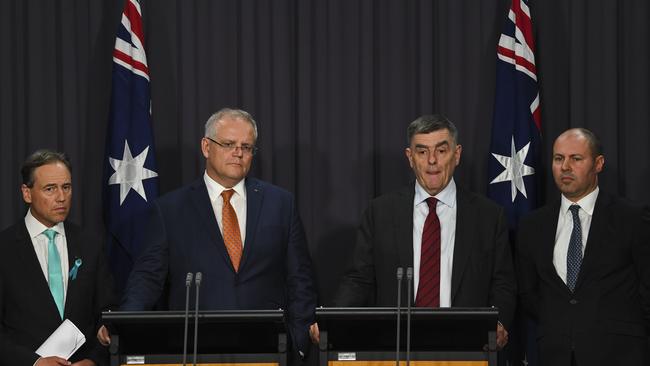
Mr Morrison told reporters in Canberra that all 15 cases identified in Australia among people who had been to the Chinese city of Wuhan had now recovered. However there were still seven “mild cases” among passengers from the Diamond Princess cruise ship.
“So, outside of those groups, there has been no human-to-human transmission in Australia,” Mr Morrison said. The self-isolation measures imposed on the more than 30,000 Australians who had recently returned from China had “proved to be very effective,” he said.
Mr Frydenberg wouldn’t indicate if the impact of the virus would wipe out the forecast budget surplus of $5 billion this financial year.
“Treasury have told me they haven’t finalised their advice on the economic impact of the virus,” Mr Frydenberg said.
“But the message is very clear. The impact will be more significant than the bushfires, and it plays out more broadly across the Australian economy.”
Asked what could be done to alleviate the effect on the budget, the PM said the options were “very limited”.
Professor Murphy said “if there is a global pandemic, then we will be prepared”.
“We have plans that have existed for years. We’ve updated them,” he said.
“And every part of the health system is now working on its plan so that we’re ready if things develop further in the future.”
Prof Murphy said “the technical definition of a ‘global pandemic’ is sustained community transmission in a number of countries. The question will evolve over the next few days to see whether the transmission in those countries can be contained or it’s sustained.
“If it is sustained in those countries — as it has been in China — I suspect the WHO would make such a call. But at the moment, they’re not making that call”.
AUSTRALIAN MARKET DIVES AMID PANDEMIC FEARS
Australian stocks have recovered some ground after plunging over fears the coronavirus outbreak could become a pandemic sparked a major sell-off on global markets.
The S&P/ASX200 index fell more than 2.5 per cent as trade began on Tuesday but by midday had recovered a little after media reports of a potential coronavirus vaccine to be trialled on people.
By 12.30pm (AEDT) the benchmark S&P/ASX200 was down 1.1 per cent at 6899.3, representing a $23bn loss in value for the sharemarket.
It is the second day of a sea of red on the local bourse, which suffered losses across the board on Monday, with $60 billion in value wiped out in its worst day in six months.
The oil price tumbled nearly 4.0 per cent overnight and global equity markets sank as investors rushed to park their money in gold, the go-to metal in times of financial concern.
But gold stocks were being sold off on the Australian Securities Exchange on Tuesday at midday.
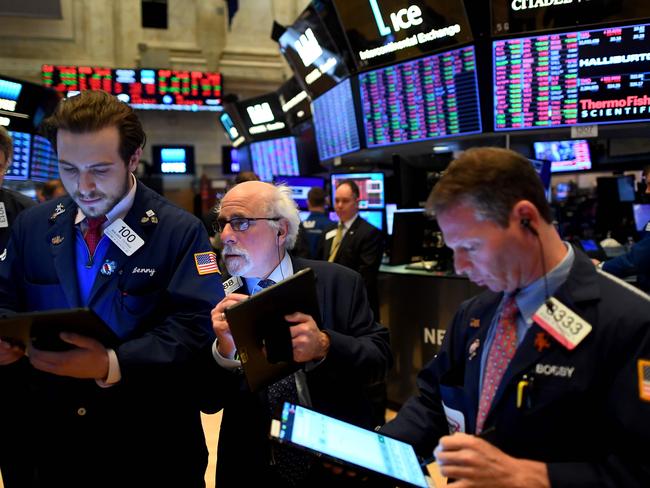
All the big banks and insurers lower. Commonwealth Bank was down $1.12 at $86.87 while National Australia Bank dropped 50 cents, or 1.84 per cent, to $26.61.
Companies in the news on Tuesday included vitamins maker Blackmores, which fell 1.61 per cent to $68.60 after saying the coronavirus and red tape in China had affected results.
Fears about the extent of the spread of COVID-19 in South Korea, Iran and Europe, and numerous other countries, drove global markets down on Monday.
The benchmark S&P 500, which represents over 44 per cent of the market capitalisation of all global equities, lost $US927 billion ($A$1.4 trillion) of its value on Monday alone.
About £76 billion ($A148 billion) was wiped off the value of companies across London’s main market, The Telegraph reports.
World Health Organisation chief Tedros Adhanom Ghebreyesus said on Monday the spread was deeply concerning but the coronavirus was not yet a pandemic. “Does this virus have pandemic potential? Absolutely, it has. Are we there yet? From our assessment, not yet,” he said on Monday.
CMC Markets and Stockbroking chief market strategist Michael McCarthy said share markets had finally moved into line with other markets after many were at record highs despite warning signs.
The disruption to supply chains if countries closed borders to contain outbreaks could see global trade grind to a halt, Mr McCarthy said.
Shane Oliver, AMP Capital’s chief economist, said the virus’s rising threat to the Australian economy added to the likelihood the central bank would cut interest rates in March or April.
It also increased pressure for more fiscal stimulus in the May budget. The Australian dollar was buying 66.08 US cents at noon AEDT on Tuesday, up from 65.97 US cents on Monday.
HOW THE SHARE COLLAPSE WILL AFFECT YOU
Why have shares dropped sharply today?
The coronavirus appears to be spreading rapidly beyond China, with large outbreaks in South Korea, Italy and Iran sparking fears it will become a global pandemic and severely damage trade and countries’ economies.
What does coronavirus mean for share investors?
Australia has kept the coronavirus contained to a small number of cases but our sharemarket is not immune to global financial market movements. When US, British and European sharemarkets drop 3-4 per cent as they did last night, we follow. Shares had recently been trading at record highs, and experts say the sharp turn in sentiment suggests more falls are likely.
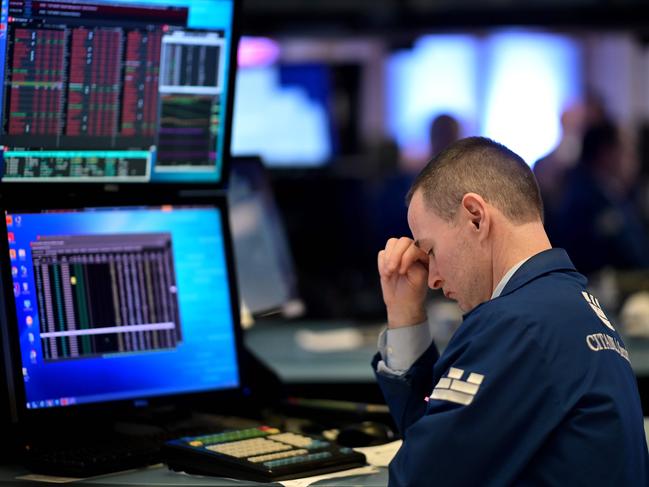
What does it mean for my superannuation?
Shares make up a significant portion of most people’s super fund investments – often at least 50 per cent. This means that falling sharemarkets will flow through to super fund returns – but remember that super had a stellar year in 2019, has been climbing for many years, and was already due for a correction.
What about the Aussie dollar?
Our currency had already been trading at 10-year lows around US66c and has not moved significantly further since last night’s sharemarket plunge. A low Aussie dollar is good for businesses that export because they get higher prices for their goods. But it’s bad for travellers heading overseas, although many travellers may have wider concerns than currency at the moment.
What do I do about my investments?
Share specialists say panicking is not the answer, and that corrections in share markets are expected. Previous global virus scares have not had huge long-term effects on share prices. However, nobody knows what will happen with coronavirus. Long-term investors and super fund members have time to ride out short-term market volatility, but active traders may want to consider taking some profits in case shares sink further fast.
‘DEEPLY CONCERNING’ CORONAVIRUS DEVELOPMENT
The World Health Organization (WHO) has labelled a surge in coronavirus cases outside China “deeply concerning” and that all countries should prepare for a “potential pandemic”
However, WHO chief Tedros Adhanom Ghebreyesu said the epidemic had peaked in China between January 23 and February 2, and the number of new cases there “has been declining steadily since then”.
“This virus can be contained,” he told reporters in Geneva, praising China for helping to prevent an even bigger spread of the disease through unprecedented lockdowns and quarantines in or near the outbreak’s epicentre.
An acceleration of cases in other parts of the world has prompted similar drastic measures. Italy has locked down 11 towns after four more deaths were reported on Monday, bringing the total to seven. Civil protection officials said at least 222 people had tested positive for the virus.
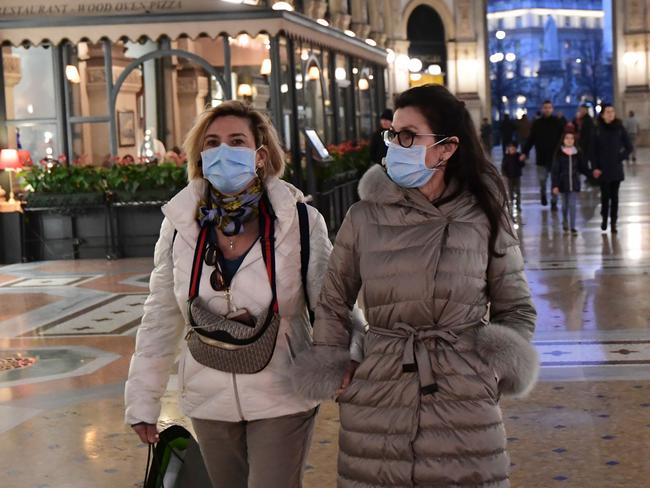
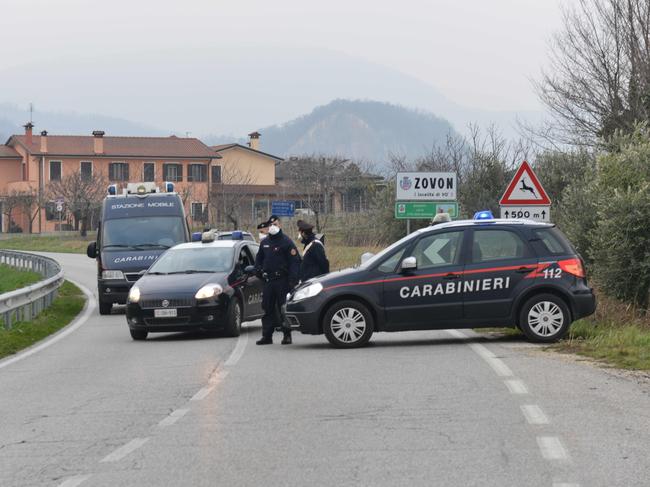
The two main infection clusters were in Lombardy and Veneto in northern Italy. Officials still hadn’t pinpointed the origin of Italy’s outbreak or whether the two clusters were related. With the numbers rising, authorities were struggling to contain the number of cases, which by Monday had spread to a half-dozen regions and prompted Austria to temporarily halt rail traffic across its border with Italy.
Meanwhile, South Korea ordered the entire 2.5 million residents of the city of Daegu to remain indoors.
It also caused falls of more than three-percent in several European stock markets – with Milan plunging 5.4 per cent – and a boost for safe-haven gold amid fears the epidemic could hit a global economic recovery.
The spread of the disease – officially known as COVID-19 – continued unabated with Afghanistan, Bahrain, Iraq, Kuwait and Oman announcing their first cases on Monday.
China also continued its preventive measures against the virus, on Monday postponing its agenda-setting annual parliament meeting for the first time since the Cultural Revolution in the 1960s.

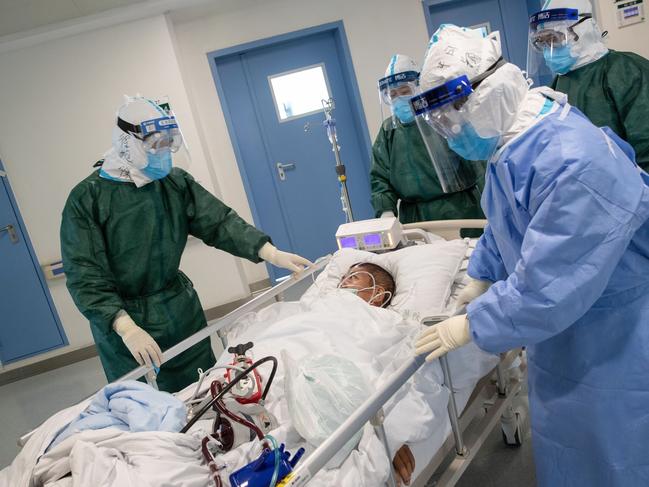
The Iranian government denied the report, and pledged transparency. Even so, authorities have only reported 64 infections in Iran, an unusually small number that would mean an extremely high mortality rate.
In China, 2,592 people have died out of 77,000 infections.
France is reportedly bracing for a tourism hit, with the outbreak depriving Paris hotels, restaurants and retailers of big-spending Chinese visitors, the latest challenge for a French tourism industry facing headwinds from homegrown protests and Brexit, officials said on Monday.
“For now, airline forecasts suggest a 60 per cent drop in Chinese visitors for February, March and April compared with the same period last year,” said Valerie Pecresse, president of the Ile-de-France region that encompasses the French capital.
“Yet Asian clients are absolutely crucial for us,” she said while presenting 2019 tourism figures for the region.
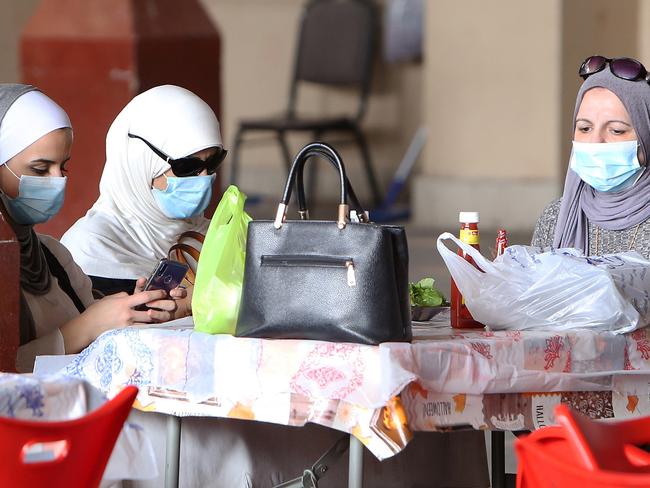
Around 950,000 Chinese visited Paris last year, making them the fifth-largest source of tourists by nationality, according to the CRT regional tourism committee.
In Australia, there have been 22 confirmed cases of COVID-19: Eight in Queensland; four in New South Wales; six in Victoria; three in South Australia; one in WA.
Of those people, 10 have recovered and the others are in stable conditions. Seven cases are passengers who were on the Diamond Princess repatriation flight from Japan. They were in quarantine at the Manigurr-ma Village Howard Springs facility in Darwin when they tested positive to coronavirus. All have returned to their home states for medical treatment.
The 266 Australian evacuees from Wuhan have all gone home after clearing a 14-day quarantine period.
AUSTRALIA RAISES TRAVEL WARNINGS AS CORONAVIRUS SPREADS
Travel warnings for Australians visiting Japan and South Korea have been ramped up to “exercise a high degree of caution” due to a spike in the number of coronavirus cases.
The federal government has lifted the travel advice to “Level 2” for both countries after sudden jump in cases confirmed in South Korea, and an increasing number in Japan in recent days.
Health Minister Greg Hunt said on Monday that the situation would continue to be monitored and reviewed if more cases develop, as the virus has infected 80,000 people globally.
“Sadly, the number of lives lost is 2466 globally to the coronavirus although those figures will inevitably be updated during the course of the day,” he said.
“Within Australia, within the general community, it remains as it has for some time now that there have been 15 cases, 10 of which have cleared the virus and the other five remains stable.”
Chief Medical Officer Professor Brendan Murphy said the continuing spread in Japan, spike in South Korea, Italy and deaths in Iran were all a “cause for concern”.
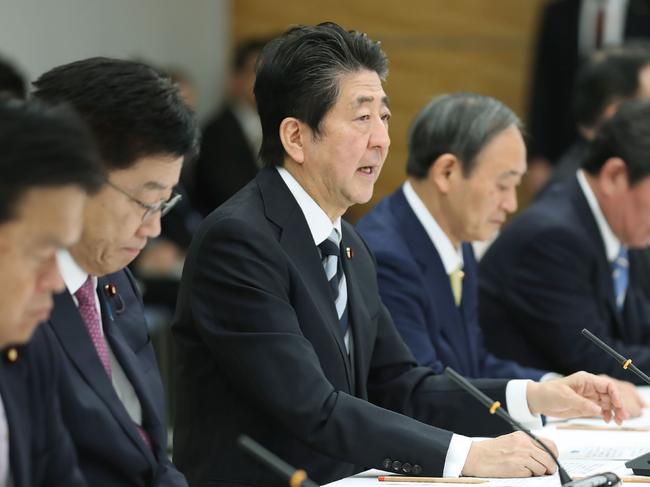
“All of those countries are making very extensive efforts to try and contain the outbreaks,” he said.
“Within China, as we have seen in previous days, the main problem continues to be in the Hubei province where there are significant growth in case numbers and increase in the number of deaths in each day.”
The number of confirmed COVID-19 cases among Australians who were on the Diamond Princess cruise ship that was quarantined in Japan remains at seven.
All of those have been evacuated to their home states and are in stable conditions.
“In Australia, there is no community transmission of the virus at present,” Prof Murphy said.
“No reason for people to feel concerned at present but we are certainly aware of developments and because of the risks posed by international developments.”
Prof Murphy said Australia had a “global pandemic plan” based on a pre-existing influenza plan that was being prepared if necessary.
“We are certainly preparing as a nation, for every eventuality,” he said.
AUSTRALIA CAUGHT UP IN ITALY OUTBREAK
Earlier, it emerged The Australian Institute of Sport has been shut down by authorities in Italy as the coronavirus claimed six lives in the country’s north.
The European hub of the AIS, in the Varese region, is 120km away from the first cluster of Italian victims in Codogno, The Australian reports.
The AIS campus is used by Australian teams and international athletes, particularly rowers and track and field athletes.
Meanwhile, an Alitalia plane has reportedly been quarantined after arriving in Mauritius and a bus from Milan was barricaded by police in the French city of Lyon for health checks.
Schools and universities were ordered closed for at least a week in the wealthy regions of Lombardy and Veneto, museums and cinemas were shut and the last two days of the Venice Carnival were cancelled.
Milan’s famous La Scala opera house cancelled performances, and bars and discos in Lombardy were told to close by 6pm local time.
Milan’s fashion week has also been affected by the virus with Giorgio Armani showing his latest collection to an empty room after guests were urged not to come.
Supermodel Bella Hadid posted a photo on Instagram leaving Milan after fashion week wearing a mask on a plane.
Some major sporting events were postponed, including four Serie A soccer matches scheduled for Sunday.
Road blocks were set up in at least some of 10 towns in Lombardy at the epicentre of the outbreak, including in Casalpusterlengo, to keep people from leaving or arriving.
Even trains transiting the area weren’t allowed to stop.
Buses, trains and other forms of public transport – including boats in Venice – were being disinfected.
Italy’s civil protection unit said the number of cases of the highly contagious virus totalled 152, all but three of them coming to light since Friday.
Prime Minister Giuseppe Conte admitted he had been caught off guard by the sharp rise in virus infections.
“I was surprised by this explosion of cases,” he told state broadcaster RAI, warning that the numbers would likely rise in the coming days.
“We will do everything we can to contain the contagion,” he said.
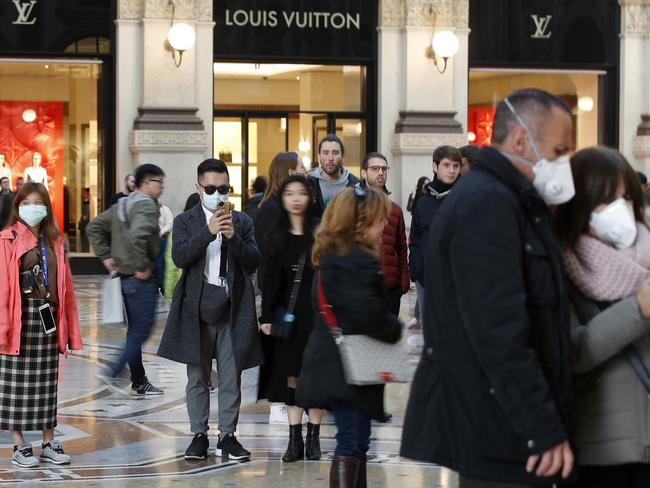
The virus claimed the life of an elderly woman from the town of Cream, some 45km east of Italy’s financial capital Milan.
Like at least one of the other people who have died, she had been suffering from serious underlying health issues, officials said.
Authorities expressed frustration that they haven’t been able to track down the source of the virus, which surfaced last week when an Italian man in his late 30s in Codogno became critically ill.
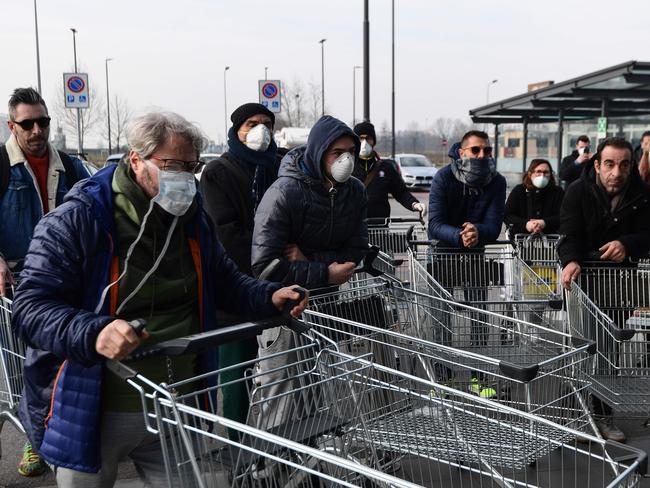
At first, it was widely presumed that the man was infected by an Italian friend he dined with and who had recently returned from his job, based in Shanghai.
But when the friend tested negative for the virus attention turned to several Chinese residents who frequent the same cafe visited by the stricken man.
SMILES, TEARS AS FAMILIES REUNITE
A NSW family who were torn apart for two months by coronavirus were happily reunited at Sydney airport in a Love Actually moment.
It was smiles and hugs all around for the Li family from North Entrance after a lengthy period of forced separation and a worrying time in quarantine in Darwin.
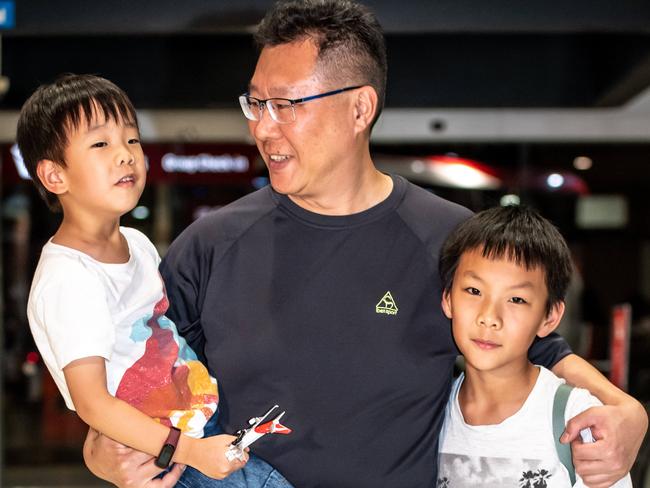
Mr Rui Li said his wife Tianshu and his children Shan and Zoe had travelled to China before Christmas last year to spend Chinese New Year with relatives when they became trapped in Wuhan, the epicentre of the coronavirus.
Mr Lui said he rang the Department of Foreign Affairs every day in a bid to get his family on one of the Qantas rescue flights out of the city.
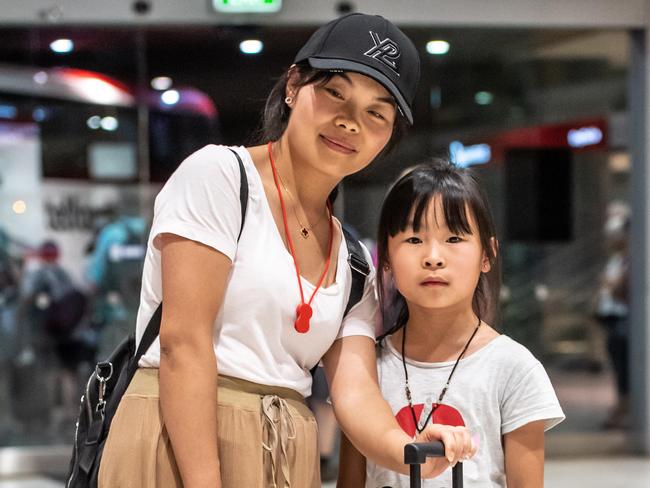
“I was very worried,” he said.
Mr Li said his wife and children were tested at five different medical check points before they were allowed to eventually board the plane before flying to Darwin where they spent two weeks in quarantine.
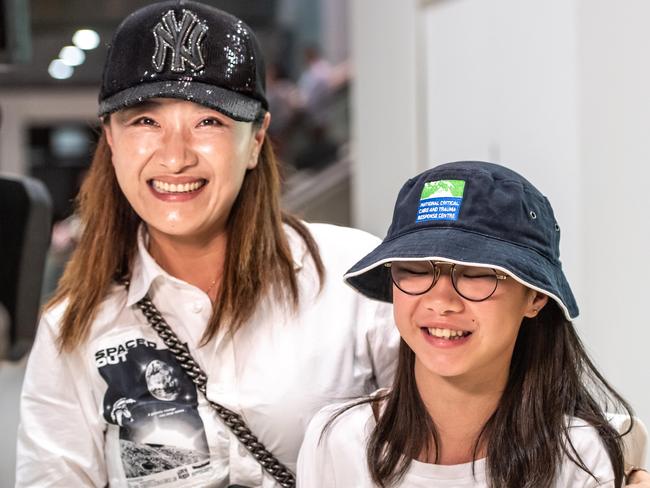
“I want to thank Australia and the Australian people,’’ Mr Li said
“When we needed them they were very helpful,” he said.
He said his children were excited to be back in Australia.
“They just want to go to school tomorrow and see their friends” he said.
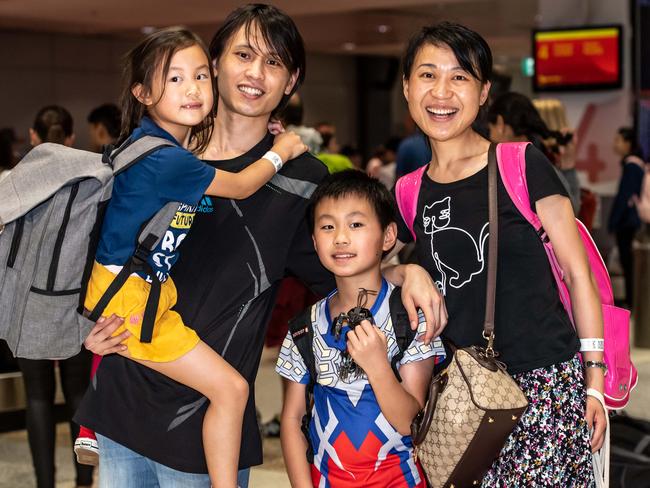
Australia’s chief medical officer professor Brendan Murphy confirmed on Sunday none of the Diamond Princess evacuees had proven positive for the virus during their time in quarantine and were flying out of the Northern Territory.
The group’s release comes as a seventh person from the cruise ship tested positive for the deadly coronavirus.
The small group – of the 164 Australians flown into Darwin on Thursday – are being repatriated to their home states for quarantine.
“They’re being taken to whatever facility the state Health Department thinks is appropriate for them. They will be isolated and monitored,” Professor Murphy said, adding there was no realistic prospect of a vaccine to the coronavirus anytime soon.
“None of them will need particularly high-level medical treatment at the moment, but they’ll be monitored and tested and isolated until they’re well and have cleared the virus.
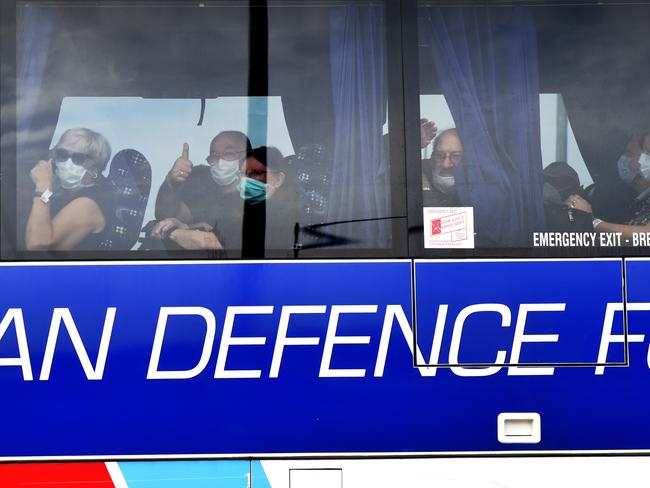
“Other than the people who have come back from the Diamond Princess cruise ship, all of our original 15 cases came from Hubei province over a fortnight ago.
“Ten of those 15 have cleared the virus and are well, and the other five are well but just waiting for final tests to clear the virus before they return to the community.”
For Australians left behind in Japan and in hospital after testing positive for the coronavirus prior to the evacuation, Professor Murphy said they could return to the country once they are cleared for the infection and have sought permission and advice from Japanese health officials.
– with staff writers and wires
Originally published as ASX suffers $23bn loss as Treasurer warns on coronavirus’ economic impact


